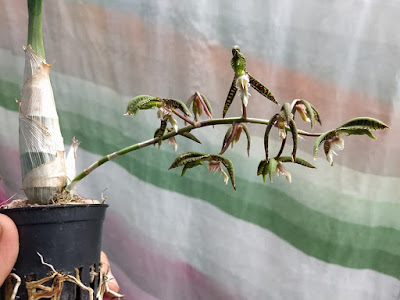Catasetum garnetianum is found in Brazil, Amazonas State, municipality of Monte Alegre. It grows in forest bordering the Amazon River at low elevation.
Catasetum garnetianum also called as Garnet's Catasetum, is a species of the genus Catasetum. This species was described by Robert Allen Rolfe in 1888.
IDENTIFY CATASETUM GARNETIANUM ORCHID PLANT
Catasetum garnetianum is found in Brazil, Amazonas State, municipality of Monte Alegre. It grows in forest bordering the Amazon River at low elevation.
It is a medium sized, hot growing epiphyte with fusiform, to 12 cm long and 2.2 cm wide pseudobulbs enveloped completely by leafless and leafbearing sheaths carrying up to 8, linear-oblanceolate, medium green, plicate, 3 prominent nerved, basally clasping, to 26 cm long and 4.5 cm wide leaves.
Garnet's Catasetum blooms in the summer to fall on a male, pendent, to 28 cm long, to 30 flowered inflorescence carrying fleshy, fragrant flowers. The flowers are 42 × 34 mm with coloration of pedicels purple-brown; sepals and petals apple green (background) with velvety brown transversal markings; appendages near the base of the lip purplish and white; tiny spots on the underside of the base of the lip purple; underside of lip apex green; trough below the lip sac very pale green; base of the lip and the tooth at the apex pearly white; column shiny green, the pollinia protuberance brown. The female flowers are not seen.
The key to identify this species is the lip and its appendages long and slender, inflorescences long, heavily flowered, and pendent. It is one of the most spectacular smaller flowered catasetums with its ample, many-flowered inflorescences, and it never fails to evoke gasps of wonder when it appears on any show table.
CATASETUM GARNETIANUM ORCHID PLANT CARE AND CULTURE
Cultural information should only be used as a guide, and should be to be adapted to suit you. Your physical location; where you grow your plants, how much time you have to devote to their care, and many other factors, will need to be taken into account. Only then can you decide on the cultural methods that best suit you and your plants.
Light:
Catasetum garnetianum are sun-loving plant and needs a light level of 30000-60000 lux. Unless the strong air movement found in the natural habitat can be duplicated, however, the grower should provide some shade (40-60 % shade). This species can be grown under lights if sufficient light intensity can be provided, and the plant certainly can be summered outdoors if their moisture requirements can be met.
Temperature:
In their natural habitat, the climate is evenly hot, moist, and tropical. This climate is almost the same year-round, with high humidity at night, even in the dry season, which is relatively short. The nighttime temperatures rarely fall below 18°C, with daytime highs generally from 29 to 35°C. The important thing is to maintain evenly warm conditions, and for this orchid the closer the night minimum is to 21°C, the better the plants will respond.
Humidity:
Garnet's Catasetum tolerate an environment with 40 - 60 % relative humidity during their growing season, but for optimal development of new growth and flowering, 70 % is recommended.
Substrate, growing media and repotting:
Catasetum garnetianum can be grown in pot, container or wooden basket with fir bark, osmunda, tree fern fiber, charcoal, and sphagnum, in various proportions or combined with still other ingredients such as sponge rock, perlite, leaf mold, peat, and bark screenings as substrate. This plant can also mounted on wood. This option presupposes that the plant is sufficiently strong, that it is not so large as to be unwieldy when hanging from its mount, that the grower can provide adequate humidity for it during the growing season, that the conversion to mounting is done at the very beginning of the growth cycle, and that the species is known to adapt readily to this cultural practice.
It is recommended to repot every year and never wait more than two years. The optimal time for potting or repotting is when new growth on a plant emerging from dormancy is about 5 cm tall and the nubs have developed into new roots that are reaching for support.
Watering:
In its natural habitat it receives rainfall frequently even while dormant. Mounted, basket-grown, and unconventionally potted plant may be watered every sunny day during the growing season, provided conditions are such that they dry off relatively quickly. In the case of conventionally potted adult plants, it should not be necessary to water more than once or, at most, twice a week. This species like to dry out at least slightly between waterings.
Fertilizer:
Fertilize with an appropriate formulation at least every week during the growing season, or fertilize with a weak formula every time the plants are watered. It is important to begin regular applications of high-nitrogen fertilizer (such as 10-5-5) with a full range of trace elements. As the leaves begin to unfurl, and well before flowering, add a high-phosphorus formula to develop big, strong pseudobulbs capable of producing robust inflorescences. Any of the soluble products with a large second-digit number (for example, 3-12-6) constitute a good source of phosphorus.
Rest period:
Catasetum garnetianum have a relatively short dormant period between leaf fall and new growth, and sometimes no dormancy at all, so the likelihood that at least some of their basic root system will survive from one growing season to the next increases. For this reason it is desirable to maintain a watering schedule, albeit reduced, during dormancy.

















COMMENTS